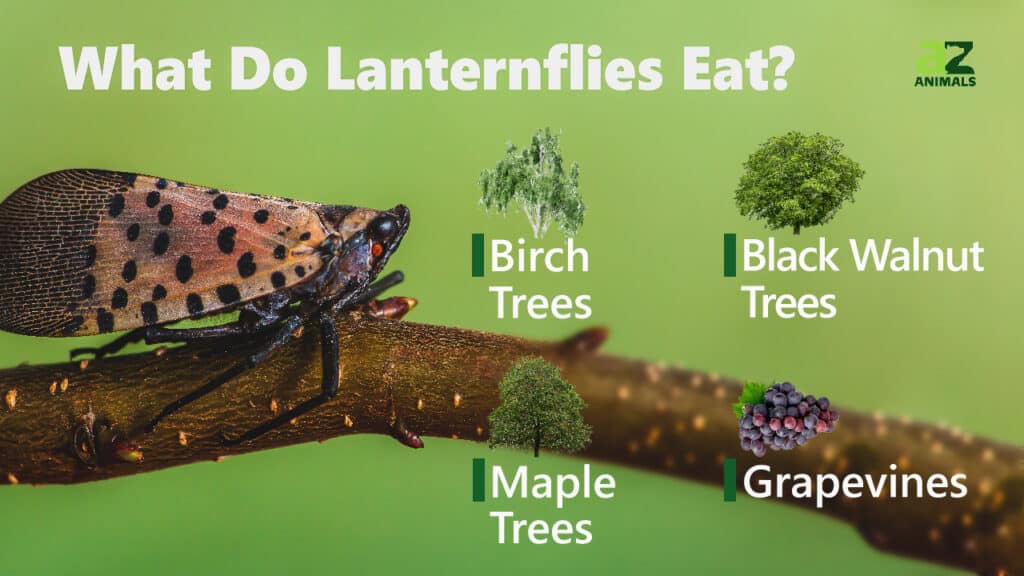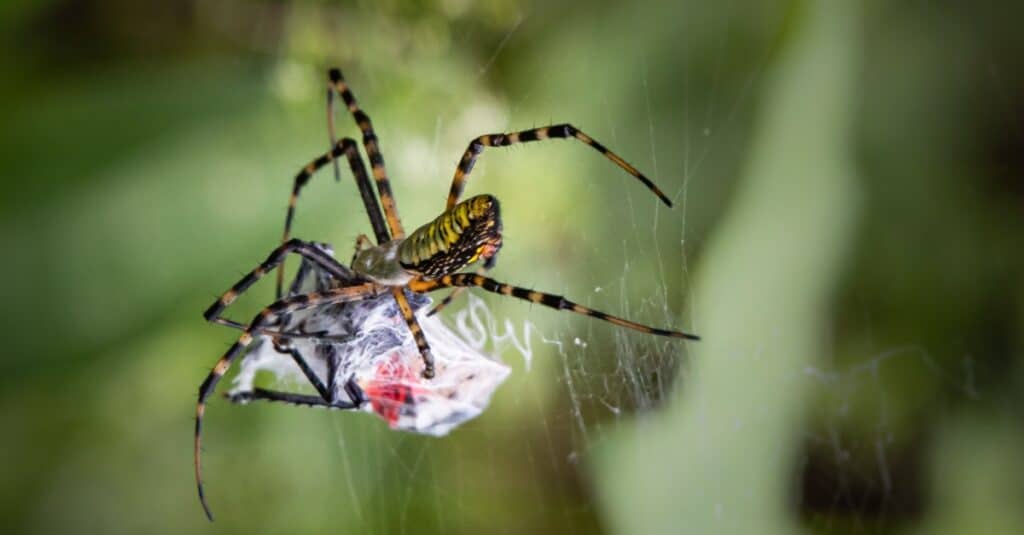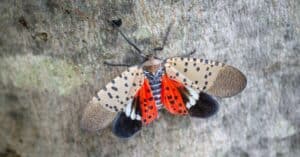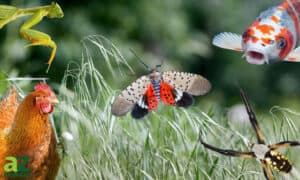Key Points:
- Spotted lanternflies resemble moths, but are classified as planthopper insects. They have piercing-sucking mouthparts that help them graze on plants while sucking up their sap.
- Spotted lanternflies are highly invasive insects, eating more than 100 different plants, including vital forestry and agricultural crops.
- In the U.S., the only predators of spotted lanternflies are spiders and the praying mantis. Yellow jackets will not go after live ones, but will eat their dead carcasses.
The spotted lanternfly is not a fly, and while they resemble moths, they are not classified as one either. These bugs, which are classified as planthopper insects, are more closely related to cicadas or aphids. They are distinguished by their piercing-sucking mouthparts, which allow them to graze on plants while sucking up all of their sap. Despite having a unique appearance, these insects are actually quite an invasive species. A number of their activities, such as feeding, contribute to significant ecological and economic damage in the United States.
So what do lanternflies eat and why are they so devastating to the environment in the United States? We uncover all of that and more in this article.
What Do Lanternflies Eat?

Lanternflies eat a diet that consists of fruit, ornamental trees, and other foods. They are predominately herbivores. Spotted lanternflies feed on the sap of plants. They eat over 100 different plants, including vital forestry and agricultural crops.
A lanternfly will eat all of the following fruits and trees:
- Almonds
- Apples
- Apricots
- Cherries
- Grapes
- Hops
- Maple Trees
- Nectarines
- Oak Trees
- Peaches
- Pine Trees
- Plums
- Poplar Trees
- Sycamore Trees
- Walnut Trees
- Willow Trees.
They favor Ailanthus trees (tree of heaven), walnuts, and grapevines as their first choices for feeding. Their second choice of food will usually be hardwood trees and then they will infrequently eat pine trees.
Spotted lanternflies eat by sucking sap from plants via a proboscis, a straw-like mouthpart. You can find the proboscis between their front two legs. They are not capable of chewing or biting trees or plants. Instead, they most likely use already existing tiny holes in tree leaf stems and tree trunks that are practically microscopic.
What Eats Lanternflies: Do They Have Predators?

Spiders are one of the few natural predators of lanternflies in the U.S.
©cwieders/Shutterstock.com
There are very few native predators that hunt and eat lanternflies in the United States. Most recently, it has been discovered that spiders will consume them if they can catch them in their webs. The praying mantis will also eat them when they can capture them, and yellow jackets appear to devour dead spotted lanternflies. However, yellow jackets do not appear to go after ones that are still alive.
In their native countries, however, they have many natural predators that keep their numbers in check. One of these in particular is a parasitic wasp. This wasp has been found to parasitize the eggs and nymphs of the spotted lanternfly. This is why the species does not run as rampant through many countries in Asia.
How Does Their Diet Impact Other Species?
Spotted lanternflies are a comparatively new pest that has been brought to the states of New Jersey, Pennsylvania, Delaware, and Maryland. They were initially discovered in Pennsylvania in 2014.
You might be wondering what it is about what lanternflies eat that makes them such a serious pest. Well, the spotted lanternfly, unlike termites, is not renowned for inflicting structural damage to trees and plants. However, lanternflies can still cause some very serious harm to the trees and surrounding plants. Lanternflies crawl on plants and trees, sucking the sap from the plant. The plant or tree may begin to wilt or die during this phase.
When spotted lanternflies feed on host plants, they also take in more sap than they can manage and excrete most of it. The secretion, sometimes known as “honeydew,” attracts other insects such as wasps and ants and causes mold development on the tree. This mold is black, has a terrible stench, and may be exceedingly difficult to remove from surfaces. It will leave a foul-smelling residue if it lands on vehicles, parts of your home, furniture, or other outdoor furnishings.
This mold may potentially impede photosynthesis and create significant distress to the tree. It will most likely perish if it cannot use light to convert water and CO2.
Spotted lanternflies are a danger to many local businesses, including lumber, orchards, and vineyards, since they cause considerable damage to native trees. They are especially hazardous to vineyards because lanternfly damage in one area of the crop can contaminate the remainder.
Are Lanternflies Dangerous to Humans?

Even though they have two sets of wings, spotted lanternflies aren’t very good at flying.
©cwieders/Shutterstock.com
Now that we know how what lanternflies eat impacts the ecosystem, you may be wondering if they can be harmful to you, or even to your pets. While these insects are bothersome, the spotted lanternfly does not bite people. As mentioned above, their mouths resemble a straw-like beak used to harvest sap from plants.
This small beak cannot pierce human skin, thus the bugs are generally harmless to people. You may feel a little pinch if one lands on you, but that won’t be from a bug bite, but from the legs landing on you. Lanternflies also aren’t harmful to pets either. However, if your dog or cat does happen to come across one and ingests it, be sure to consult with your veterinarian just in case.
What to Do if You Come Across a Lanternfly in the United States
Spotted lanternflies are found in several states, each with its own unique procedure for handling sighting reports. The United States Department of Agriculture (USDA) provides reporting statistics for each impacted state. If you discover a spotted lanternfly outside of an area where it is known to be prevalent, you should contact your state agriculture department for assistance.
Individuals can take numerous courses of action to keep the lanternfly population from continuing to spread. These include inspecting your vehicle and items for insects and eggs, removing their preferred host tree from your yard, parking away from trees, and keeping your windows closed, especially in areas where spotted lanternflies are known to be present.
There are also many types of spotted lanternfly traps on the market to help people deal with the pests in their own yards.
To avoid future spread and harm from these insects, the USDA recommends that live insects and their eggs be removed and destroyed.
What Do Lanternflies Hate?

Create your own lanternfly repellent with essential oils, white vinegar, or dish soap.
©FotoHelin/Shutterstock.com
If you would like to create a lanternfly repellent, just a few ingredients should do the trick. Adding a few drops of essential oils, such as peppermint oil, tea tree oil, or lavender oil, to water in a spray bottle will deter and even kill lanternflies. The strong odor from these oils make it difficult for the pesky bugs to survive. If essential oils aren’t your thing, some make their own homemade traps or sprays that contain other natural ingredients such as rubbing alcohol, vinegar and water, or cider vinegar and dish soap. Equal parts of Dawn dish soap and water mixed together will kill lanternflies and their eggs.
Summary of What Lanternflies Eat
Lanternflies eat a diet that consists of fruit, ornamental trees, and other foods. Spotted lanternflies feed on the sap of more than 100 different plants, including agricultural crops. These invasive insects damage trees and property because once they feed, they excrete extra sap that causes black, foul-smelling mold to develop.
Here’s a recap of some of the lanternfly’s food sources that we looked at.
| Number | Category | Food Source |
|---|---|---|
| 1 | Fruit | Apples, apricots, cherries, nectarines, peaches, plums |
| 2 | Trees | Birch, black walnut, maple, oak, pine, poplar, sycamore, walnut, willow |
| 3 | Seeds | Almonds |
| 4 | Crops | Grapevines, hops |
The photo featured at the top of this post is © Tim UR/Shutterstock.com
Thank you for reading! Have some feedback for us? Contact the AZ Animals editorial team.







